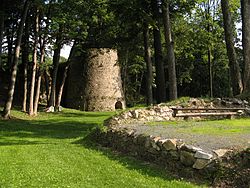Supíkovice (German: Saubsdorf) is a municipality and village in Jeseník District in the Olomouc Region of the Czech Republic. It has about 600 inhabitants.
Supíkovice | |
|---|---|
 | |
| Coordinates: 50°17′52″N 17°15′19″E / 50.29778°N 17.25528°E | |
| Country | |
| Region | Olomouc |
| District | Jeseník |
| First mentioned | 1284 |
| Area | |
• Total | 9.28 km2 (3.58 sq mi) |
| Elevation | 407 m (1,335 ft) |
| Population (2024-01-01)[1] | |
• Total | 644 |
| • Density | 69/km2 (180/sq mi) |
| Time zone | UTC+1 (CET) |
| • Summer (DST) | UTC+2 (CEST) |
| Postal code | 790 51 |
| Website | www |
Etymology
editThe name is probably derived from the personal Slavic name Šupík, while the German name is thought to have been created by transcription.[2] The Czech name has been used again since 1924.[3]
Geography
editSupíkovice is located 8 kilometres (5 mi) northeast of Jeseník and 77 km (48 mi) north of Olomouc. It lies on the border between the Golden Mountains and Zlatohorská Highlands. The highest point is the hill Křemenáč at 735 m (2,411 ft) above sea level.
History
editThe first written mention of Supíkovice is from 1284, when it was part of fragmented Piast-ruled Poland.[2] It soon became part of the Duchy of Nysa, which later on passed under Bohemian suzerainty, and following the duchy's dissolution in 1850, it was incorporated directly into Bohemia.
The municipality was in the past known for limestone quarries and lime production. In the second half of the 19th century, the municipality became known for mining and processing of granite and marble.[2]
Following World War I, from 1918, the municipality formed part of Czechoslovakia and from 1938 to 1945 it was occupied by Germany. During World War II, the Germans operated the E166 and E577 forced labour subcamps of the Stalag VIII-B/344 prisoner-of-war camp for Allied POWs in the village.[4]
Demographics
edit
|
|
| ||||||||||||||||||||||||||||||||||||||||||||||||||||||
| Source: Censuses[5][6] | ||||||||||||||||||||||||||||||||||||||||||||||||||||||||
Transport
editThere are no railways or major roads passing through the municipality.
Sights
editThe only protected cultural monument is a lime kiln from the 19th century.[7]
The oldest building in Supíkovice is the Church of Saint Hedwig. It dates from the 16th century.[8]
Notable people
edit- Petr Ševčík (born 1994), footballer; grew up here
References
edit- ^ "Population of Municipalities – 1 January 2024". Czech Statistical Office. 2024-05-17.
- ^ a b c "Historie Supíkovic" (in Czech). Obec Supíkovice. Retrieved 2022-01-25.
- ^ "O obci" (in Czech). Obec Supíkovice. Retrieved 2022-01-25.
- ^ "Working Parties". lamsdorf.com. Archived from the original on 2020-10-29. Retrieved 2021-11-12.
- ^ "Historický lexikon obcí České republiky 1869–2011" (in Czech). Czech Statistical Office. 2015-12-21.
- ^ "Population Census 2021: Population by sex". Public Database. Czech Statistical Office. 2021-03-27.
- ^ "Výsledky vyhledávání: Kulturní památky, obec Supíkovice". Ústřední seznam kulturních památek (in Czech). National Heritage Institute. Retrieved 2024-08-27.
- ^ "O Supíkovicích" (in Czech). Děkanát Jeseník. Retrieved 2023-05-26.


